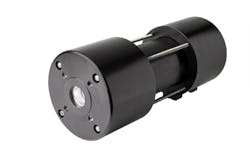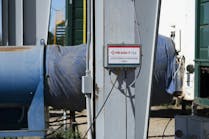Prevent moisture with high-flow membrane air dryer
Preventing moisture condensation is a common challenge in many industrial applications such as in manufacturing facilities, mining, oilfield and offshore drilling, construction and marine. The high-flow membrane air dryer will help combat the challenge of dealing with moisture condensation.
Air contains moisture, and the moisture in the air will begin to condense when it reaches the saturation point, which is known as the dew point. At saturation, the relative humidity of the air is 100 percent.
End users rely on air dryers to prevent moisture condensation in their processing equipment. Sometimes refrigeration dryers and desiccant dryers do not meet performance requirements — such as in hot, ambient temperatures and hazardous environments where electricity cannot be used or remote environments that are expensive to access and support. Recent technology developments have made dryers more effective in such situations as well as more compact and energy-efficient. High-flow membrane air dryers for moisture condensation prevention in compressed air systems now provide air flows previously unattainable in a single module.
New technology satisfies five critical requirements for industrial end users seeking moisture prevention in many regions of the world:
- Condensate management
- Portability
- Zero or low power usage
- Effective functionality in extreme heat conditions
- Space savings
Technology attributes of the high-flow membrane air dryer
An example of new compressed air-drying technology is Pentair’s Fluid Pro Hover high-flow membrane air dryer, which is designed to maintain a relative humidity at or below 50 percent. A 50 percent, relative humidity level is well below the saturation point, thus reducing the risk of condensation without the condensate disposal costs, installation constraints and electric power expenses required by other drying methods. The design supports inlet air flows as high as 9.6 m³/min (330 cfm) in a package that is less than 20 inches long. Unlike fixed dew point drying solutions that can cause excessive or inadequate drying, this air dryer maintains conditions just under the dew point. This dew point suppression results from the removal of water from the incoming air steam. The compact module delivers a moisture level that is too low for water condensation to occur. Although many compressed air-drying methods achieve ultra-low dew points as low as -40˚C (-40˚F), attaining this level of extreme dryness may add an unnecessary expense if it is not required.
Pentair’s Fluid Pro Hover high-flow membrane air dryer
Installation of the high-flow membrane air dryer
A compressed air dryer is suitable for many industrial applications including those in extremely rugged environments such as mines and deserts.
- Inline dehydration for constrained spaces, mobile applications and upgrades. Single-module design provides manufacturing simplicity and in-line moisture removal. The dryer is mounted, then the ports are connected to the appropriate air streams and the unit provides dry, compressed air. Units can be mounted in any orientation or plumbed together with multiple modules for even greater dew point suppression or higher flow capacities in stationary or skidded installations.
For remote, hard-to-reach areas or portable skids, a dryer is an easy upgrade. Unlike desiccant or refrigerated compressed air dryers, which require electricity, this unit can be installed inline in a section of piping to dehydrate the air without a power source, making this solution especially suitable to upgrade outdoor and remote piping applications that are not pre-wired.
- Purge control port for maximum control. For maximum control and maximum flexibility, the purge control port feature enables end users to turn purge air on and off or even change purge flow rates. This helps to enable purge waste minimization. It can also allow the utilization of a purge gas other than the gas that is being dehydrated. The ability to control the purge may also help to reduce purge usage in cycling applications.
Real-world installations
End users in marine, oilfield and offshore drilling rig, railroad, mining, construction and manufacturing operations are benefitting from the dryer’s small footprint, ease of installation and maintenance, and lack of power requirements.
Marine applications
The dryer is suitable for use with main air compressors, topping up compressors, deck air compressors, and emergency air compressors aboard ships. This solution competes effectively with a refrigerant dryer that supports ship operations; an absorption dryer that lowers dew point requirements to 70 degrees Celsius; and a membrane dryer that supports remote locations. The dryer can also be used to complement another dehydration technology for optimal performance.
Oilfield and offshore drilling rig applications
The types of compressors that the dryer supports for drilling rigs include rig air compressors, bulk air compressors, color-start air compressors, flare boom air compressors, and explosion-proof air compressors. Technologies for drilling applications that the dryer effectively supports include refrigerant dryers for the main engine and rig tensioning; the desiccant dryer for air drilling and lowering dew points to -40 °C; and membrane dryer for remote locations with high-volume drilling operations.
Mining applications
In mining applications especially, costs related to the use of compressed air make up 20 percent of the total costs related to underground mining. Also, approximately 20 to 40 percent of energy costs can be attributed to compressed air systems.
Main air compressors for surface mining applications, underground air compressors, portable air compressors and breathing air compressors can be supported with the dryer.
Construction applications
In the construction process, the dryer supports main air compressors and portable air compressors. It can be an effective alternative to portable desiccant dryers and membrane dryers used in remote locations.
Manufacturing applications
The dryer plays a vital role in the operations of Pentair’s own manufacturing facility in St. Paul, Minnesota, as well as in original equipment manufacturer (OEM) facilities in several countries.
The manufacturing plant uses two of these dryers installed in the compressor room. The manufacturer has two 75-horsepower compressors with one dyer installed downstream of each compressor. High-quality air filtration and coalescers are situated between the compressor and the dryer to help remove oil vapors, particulates and liquids. The dryer is set to reduce the dew point of the compressed air to a level that prevents condensation in downstream compressed air plumbing such as the receiver tank, downstream plumbing and other valuable manufacturing equipment that this factory relies on daily to build products.
Conclusion
This next generation of membrane dryer technology with advanced hollow fiber module design can offer an effective solution for meeting high-flow, low-dew point suppression needs with little required maintenance.




